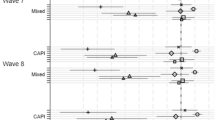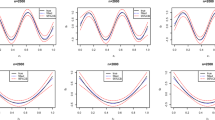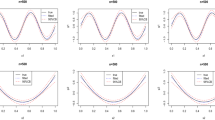Abstract
Nonresponse is of major concern to social scientists, due to the possibility of selectivity: not all groups in the population are equally represented in the final sample, when some groups have a larger probability to be in the sample than others. It is dangerous to base conclusions on such biased samples. Therefore, it is of importance to study nonresponse patterns. First it is shown that a decreasing nonresponse for every successive wave indicates that nonresponse is selective to a degree. Successively we discuss how Markov models can be used to get some idea of the seriousness of this bias in the sample, by examining how many chains are needed to reproduce the observed pattern of nonresponse acceptably well, and what the probability is that members of these chains will participate in a particular wave of the study. A small application is given, after which the implications of the findings are discussed.
Similar content being viewed by others
References
Anderson, T.W. (1954). Probability models for analyzing time changes in attitudes, in P.F.Lazarsfeld (ed.), Mathematical Thinking in the Social Sciences, Glencoe, IL: The Free Press.
Bartholomew, D.J. (1981). Mathematical Models in Social Science, New York: Wiley.
Blumen, I., Kogan, M. & McCarthy, P.J. (1966). Probability models for mobility, in P.F.Lazarsfeld & N.W.Henry (eds.), Readings in Mathematical Social Science, Cambridge, MA: MIT Press, pp. 318–334.
Chung, K.L. (1967). Markov Chains with Stationary Transition Matrices, Berlin: Springer.
Coleman, J.S. (1968). The mathematical study of change, in H.M.Blalock & A.B.Blalock (eds.), Methodology in Social Research, New York: McGraw-Hill, pp. 428–478.
Dijkstra, W.D. (ed.) (1993). Het proces van sociale integratie van jong-volwassenen (The process of social integration of young adults), Amsterdam: VU-Uitgeverij.
Freedman, D. (1970). Markov Chains, San Francisco: Holden-Day.
Goyder, J. (1987). The Silent Minority, Cambridge: Blackwell University Press.
Hox, J.J. & DeLeeuw, E.D. (1993). Nonrespons bij schriftelijke vragenlijsten, telefonische interviews en face-to-face interviews: een vergelijkende meta-analyse (Nonresponse in mail surveys, telephone interviews and face-to-face interviews: A comparative meta-analysis), Kwantitatieve Methoden, 14, 59–78.
Langeheine, R. & Van de Pol, F.J.R. (1989). A unifying framework for Markov modeling in discrete space and discrete time, Sociological Methods & Research, 18.
Markus, G.B. (1979). Analyzing Panel Data, Beverly Hills: Sage.
Poulsen, C.S. (1982). Latent Structure Analysis with Choice Modeling Applications, Philadelphia: Wharton School (Unpublished PhD-dissertation).
Taris, T.W. (1994). Representativiteit en nonresponse in panel studies: een korte notitie (Representativity and nonresponse in panel studies: A short note). Kwantitatieve Methoden, 16, 41–44.
Taris, T.W. (1995). On Selectivity of Nonresponse in Discrete-Time Multi-Wave Panel Studies. Manuscript submitted for publication.
Taris, T.W., Van derVaart, W. & Dijkstra, W.D. (1993). Nonrespons en de representativiteit van de follow-up metingen (Nonresponse and representativity of the follow-up waves), in W.D.Dijkstra (ed.), Het proces van sociale integratie van jong-volwassenen, Amsterdam: VU-Uitgeverij, pp. 65–76.
Van dePol, F.J.R. (1989). Issues of Design and Analysis of Panels, Amsterdam: Sociometric Research Foundation.
Van dePol, F.J.R., DeJong, W. & Langeheine, R. (1990). PANMARK 2.2 User Manual: Panel Analysis using Markov Chains, Voorburg: Netherlands Central Bureau of Statistics CBS.
Van de Pol, F.J.R. & Langeheine, R. (1989). Mixed Markov latent class models, from description toward explanation, in C.C. Clog (ed.), Sociological Methodology 1990.
Wiggins, L.M. (1973). Panel Analysis, Latent Probability Models for Attitude and Behavior Processes, Amsterdam: Elsevier.
Author information
Authors and Affiliations
Rights and permissions
About this article
Cite this article
Taris, T.W. Modeling nonresponse in multiwave panel studies using discrete-time Markov models. Qual Quant 30, 189–203 (1996). https://doi.org/10.1007/BF00153987
Issue Date:
DOI: https://doi.org/10.1007/BF00153987




